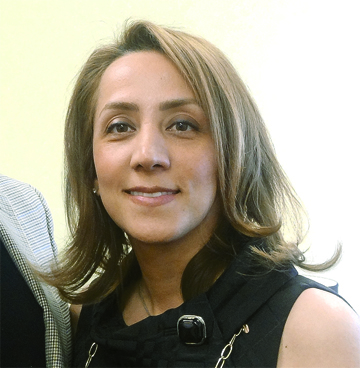
by Mark Smiley | Oct 23, 2017 | Feature Story Bottom Left

Shideh Kerman
by Shideh Kerman, BS, MBA
AFC Urgent Care Denver
On October 13, the White House press office announced that the administration would stop Obamacare subsidies or Cost-Sharing Reductions. These subsidies were designed under Obamacare to help low or moderate income Americans with their out of pocket expenses if they buy insurance through one of the Obamacare plans. There’s a lot that’s still uncertain about how this action will change the health law.
How do cost-sharing reductions work?
The Cost-Sharing Reductions or CSRs were federal funding to insurance companies to reduce the out-of-pocket expenses of low to moderate income individuals and families that would purchase one of the Obamacare health plans. The CSRs were a pass-through from the government via insurance companies to the patients.
“These subsidies are not a bailout — they are passed from the federal government through health plans to medical providers to help lower costs for patients who see a doctor to treat their cancer or fill a prescription for a life-saving medication,” America’s Health Insurance Plans and the Blue Cross Blue Shield Association said in a joint statement.
What will this mean for people who get insurance through their employers?
Consumers that get healthcare coverage through large companies that offer insurance, will see minimal changes. But if you work for a small business, there is a high chance that you will see more changes to your healthcare coverage. The executive order asks the Labor Department to loosen rules that permit small companies to band together to form associations and buy the kind of coverage available to larger businesses. These association health plans would be subject to federal employment law and not state insurance regulations. That means that the health plans would have far fewer rules benefits.
Small businesses that decide not to join such associations might face higher premiums in the exchange market.
How would eliminating cost-sharing reductions affect people who buy their own insurance?
It’s complicated. The proposed amount of subsidies in 2018 by insurance companies was estimated around $7 billion. With the executive order cutting this funding the biggest risk to consumers is that insurance companies will drop out of the market for next year. That makes the exchange markets less attractive for consumers.
Colorado has a state-run exchange, which is called Connect for Health Colorado. Our state is among just 12 states (including DC) that are running their own exchanges and enrollment platforms coverage. Although some insurance companies exited the Colorado exchange, Connect for Health Colorado is still among the most robust exchanges in the country, with seven insurance companies offering plans.
Insurance companies that opted to stay on the exchange market would raise their premiums to make up for the lost subsidies.
Analysts say that marketplace insurers across the country would likely raise premiums for silver plans, which is anywhere from 9 to 27 percent.
These premium increases were approved based on the assumption that CSRs funding would continue to be made to insurance companies. Insurance companies agreed to later add another 6 percent to premiums if CSRs funding were to be eliminated. So now that the CSR funding has been eliminated the average rate increase will be about 32.7 percent, instead of the previously estimated 27 percent.
But this increase in premiums doesn’t mean that all the consumers that purchase health insurance in the market place will pay more. Under the Affordable Care Act (ACA), tax credits for purchasing health insurance in the marketplaces are designed to limit consumer’s premium contributions to a percentage of their income. Families and individuals making between 100 percent to 400 percent of the poverty level will receive tax credits, which will offset the premiums increases.
So for low or medium income people who are eligible for tax credits the premium increases for 2018 will be offset by tax credits.
A recent study by Kaiser Family Foundation shows that for a 40-year-old non-smoker in Denver that earns $30,000 a year, he or she will actually pay 3 percent less, after tax credits, for the second-lowest-cost silver health plan in 2018.
So Consumers who get insurance through market exchanges using government subsidies won’t notice much of a change in price, but they might see fewer options in the future.
Consumers who won’t be eligible for any subsidies that used to purchase their health insurance through exchange markets will be most affected by the CSRs funding cuts. Higher premiums and less choices will make the exchange market less attractive, thus many consumers will leave the exchange market leading to more uninsured people.

by Valley Gadfly | Oct 23, 2017 | Valley Gadfly
“It was a dark and stormy night, suddenly, a turkey rang out!” Those are Charlie Brown’s words after Lucy told him to write a Thanksgiving novel. It’s been 44 years since A Charlie Brown Thanksgiving made its way to our TV screens, but it still reminds us of the true meaning of Thanksgiving and the beginning of the holiday season.
Sure, turkey, stuffing and pumpkin pie star on our gratefully plentiful holiday tables, but we all know it’s really our loved ones who make Thanksgiving special.
Here are our healthy and fresh choices for shopping, dining and entertainment to add more food, love, friends and generosity to your traditional November recipe:
3 Good grief, don’t miss out on the Denver Film Festival screening more than 200 titles including three red carpet galas at the Ellie, Nov. 1-12. Other events are at the Sie Film Center. Information: 720-381-0813.
3 Get in the holiday mood shopping the Colorado Country Gift Show with 450 booths in the Denver Mart, Nov. 3-5. Information: 800-521-7469.
3 Hip-hop over to the Buell Theatre for Breakin’ Convention, the big hip-hop dance festival with workshops, Nov. 4-5. Information: 303-893-4100.
3 Embrace the holiday spirit by attending the Lowry Fall Wine Tasting in Eisenhower Chapel Nov. 10, 6-8:30 p.m. Information: 303-344-0481.
3 Enjoy Thanksgiving without cooking by feasting on the annual classic roast turkey spread at the Monaco Inn Restaurant, 11 a.m.-6 p.m. A half-dozen other scrumptious choices also offered. Information: 303-320-1104.
3 Thanksgiving is the only holiday allowing a little shuteye mid-event. Hence, keep a happy-healthy home with better mattresses and better sleep from SleepNation with three Valley locations: Information: 720-443-4421.
3 Enjoy Epic Night with 12 bands, dancing, free food-drinks at Swallow Hill’s Tuft Theatre benefit Nov. 18, 7 p.m. Information: 303-777-1003.
3 Join the Mile High United Way Turkey Trot at Wash Park to make the big meal satisfying Nov. 23, 10:15 a.m.-2 p.m. Information: 303-433-8383.
3 Book your plans now for The Bookies Small Business Saturday in Glendale Nov. 26, 10 a.m.-4 p.m. After two days off they’re throwing open the doors for the Author Showcase. Hear authors speak throughout the day as you shop and enjoy entertainment. Furthermore it’s a day to celebrate independent bookstores and the usual store discounts apply. On day after Thanksgiving it’s fun shopping. Information: 303-759-1117.
Your Thanksgiving menu likely won’t include toast, popcorn and candy, as was the case for the Charlie Brown TV special based on Charles M. Schultz’s Peanuts comic strip. Nevertheless, today the Peanuts comic strip is as synonymous with Thanksgiving as turkey, pumpkin pie and awkward family conversations about politics and religion.
In that TV special Lucy enticed Charlie Brown to kick the football because it was a Thanksgiving tradition. Now the NFL has ostensibly pulled the same trick on us.
A parade, big meal and mind-numbing football games highlight Thanksgiving. So why is it more appetizing than others? For many of us it delivers four days off. How awesome is that? It’s also universal, inclusive and nap friendly. Plus thankfulness makes us happy. Share your good fortune with food banks or soup kitchens and bon appetite!
— Glen Richardson
The Valley Gadfly can be reached at newspaper@glendalecherrycreek.com.
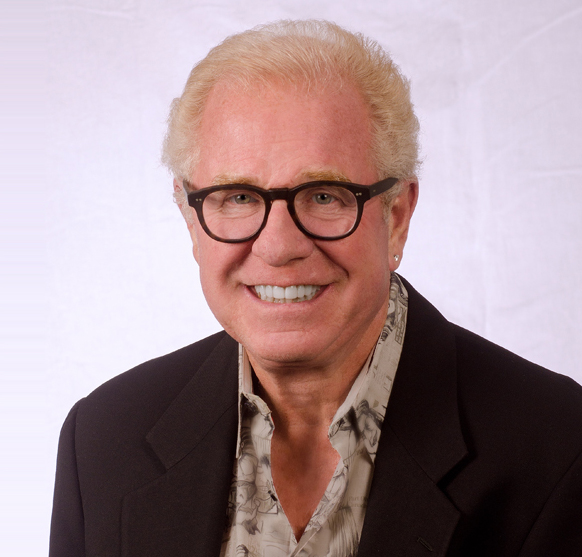
by Peter Boyles | Oct 23, 2017 | Blasting with Boyles
 December 2016 I wrote here in the Chronicle a column titled “Brandon Marshall Stands Up, Brownstein-Farber Takes A Knee.” I talked about the overwhelming amount of lies Denver Broncos linebacker Brandon Marshall told about what happened to him in Miami a year ago last summer. How, if memory serves me well, five cops jumped him, a Taser placed on his chest, the handcuffs put on him, placed in the back of a police car, driven somewhere, brought back where he was finally told, “If you don’t say anything we won’t say anything.” And that dear reader was the reason why Brandon Marshall says he took a knee.
December 2016 I wrote here in the Chronicle a column titled “Brandon Marshall Stands Up, Brownstein-Farber Takes A Knee.” I talked about the overwhelming amount of lies Denver Broncos linebacker Brandon Marshall told about what happened to him in Miami a year ago last summer. How, if memory serves me well, five cops jumped him, a Taser placed on his chest, the handcuffs put on him, placed in the back of a police car, driven somewhere, brought back where he was finally told, “If you don’t say anything we won’t say anything.” And that dear reader was the reason why Brandon Marshall says he took a knee.
The Denver Post is celebrating 125 years of being in the newspaper business. I think it’s more like 115 because they’ve been mailing this baby in for the last 10.
A couple of weekends ago The Denver Post, as hard as it to imagine, literally outdid itself in attempting to scam the Mile High City. Nicki Jhabvala known on our 710 KNUS radio as Nicki “Jambalaya” did a piece along with other hard-hitting Denver media representatives, with above said Brandon Marshall as he explained why he continues to do the clenched fist and other versions of taking a knee. Only this time the Miami fight with the law never comes up. Fascinated? Not one of those hard-hitting media members dared ask Brandon, “Hey man, the last time you talked to us you told us the cops did stuff to you in Florida. Why has that reason disappeared?” Are they just afraid? Misinformed? Hells bells, Nicki did the original story a year ago about the adventures of Brandon Marshall in Florida. I guess like some New York mobster on trial these gatekeepers of the truth have conveniently forgotten.
But The Denver Post gets worse. In their lead editorial October 13 of this year written by the entire Denver Post Editorial Board they go after Denver Police Corporal Zachery Phillips. Now here is the first sentence of that editorial and I quote… “Something is wrong when investigators can determine it is more likely than not that a Denver police officer paid a known prostitute for sex and lied about it and the officer keeps his job…”
Now substitute “Denver Mayor Michael Hancock.” If you all recall when Councilman/Mayor-Elect Hancock was visiting the working girls at Denver Players and Sugar, we had the call sheets. Some of the soiled doves ID’d his photo and The Denver Post and the Brownstein law firm offered him total protection.
Now they’re upset that Corporal Phillip paid for sex. Damn.
My next example of a great 115 years is George Lopez, booed off the stage after Trump jokes flop at a recent Denver gala. Now you would think that’s a huge deal, telling wealthy donors that they have white privilege and his opinion of old white men. Classy. But other than reading it in the New York papers it appeared six paragraphs in in the Post society column by Joanne Davidson.
Now flip it. George Lopez attacks Trump and gets a standing ovation. Sports fans that’s front page.
So why do you think nobody in the Denver media covered George Lopez? And as he has done many times Ed Greene Channel 4 Weatherman and KOA Radio anchor comes in for the save. I wonder if George cashed the check?
So there we have it folks. What do these three things have in common? Brandon Marshall, George Lopez and The Denver Post Editorial Board? Sex, lies and videotape. Or is there any way Norm and Steve can sleaze a dollar out of this deal?
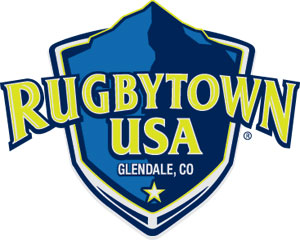
by Mark Smiley | Sep 25, 2017 | Glendale City News
by John Arthur
Writer for and on behalf of the City of Glendale
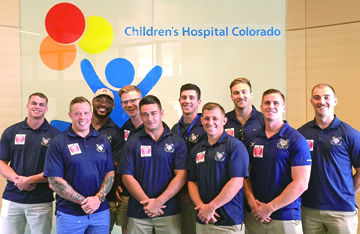 Glendale’s Infinity Park, home to the city’s Raptors and Merlins rugby teams, has a longstanding history of positively engaging local communities. In the late-August days leading to Infinity Park’s annual RugbyTown Sevens tournament, that tradition of outreach was further strengthened. With organizational help from Infinity Park hosts, Armed Forces teams participating in the tournament paid visits to Children’s Hospital Colorado, putting smiles on faces young and old, and demonstrating the alignment of outreach and inclusion indicative of rugby’s values and those of military service.
Glendale’s Infinity Park, home to the city’s Raptors and Merlins rugby teams, has a longstanding history of positively engaging local communities. In the late-August days leading to Infinity Park’s annual RugbyTown Sevens tournament, that tradition of outreach was further strengthened. With organizational help from Infinity Park hosts, Armed Forces teams participating in the tournament paid visits to Children’s Hospital Colorado, putting smiles on faces young and old, and demonstrating the alignment of outreach and inclusion indicative of rugby’s values and those of military service.
Founded in 1908, Children’s Hospital Colorado has been providing outstanding pediatric care for over a century. The private, not-for-profit provider is affiliated with the University of Colorado School of Medicine, and is ranked as a best national children’s hospital by U.S. News & World Report. With both national and international Armed Forces teams visiting in the week leading up to the RugbyTown Sevens tournament, patients and their families experienced firsthand the compassion and character definitive of rugby athletes.
Dacoda Worth, a rookie playing for the Army Rugby 7s team, reflected on his first appearance at the tournament, and in participating in community outreach: “Through rugby, and the military in general, the best feeling is giving back. That’s what we’re doing every day through our service, and giving back here, visiting these kids, as a rugby player and a serviceman is really rewarding.”
RugbyTown Sevens, an annual Glendale tournament attracting teams from across the globe and producing competition at the highest level, served as backdrop for the visits to Children’s Hospital. Representatives from the U.S. Marines, Army, Navy, and Coast Guard teams, as well as from the British Royal Air Force participated in the visits.
Rob Bell, making his second appearance at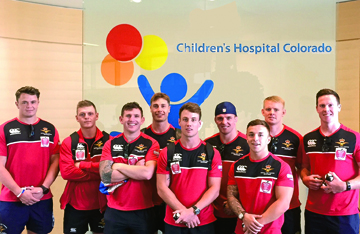 the RugbyTown tournament with the Royal Air Force team, quipped that the hospital visit was an important aspect of the experience, and that there was more to the tournament, and rugby, than just the competition: “If you look at rugby in America, it’s grown and grown. With the military teams all coming to the hospital and interacting with the kids, it sends a really positive message. We’re here to engage with the local community — not just to play. It’s very important.” Bell went on to note the similarities between the values inherent in rugby as a sport and those of military service: “Rugby aligns with military values: respect, integrity, service, friendship, ethics, and camaraderie. There’s a massive crossover with the values of rugby. Outreach like this helps us demonstrate that to the public in a way that’s meaningful.”
the RugbyTown tournament with the Royal Air Force team, quipped that the hospital visit was an important aspect of the experience, and that there was more to the tournament, and rugby, than just the competition: “If you look at rugby in America, it’s grown and grown. With the military teams all coming to the hospital and interacting with the kids, it sends a really positive message. We’re here to engage with the local community — not just to play. It’s very important.” Bell went on to note the similarities between the values inherent in rugby as a sport and those of military service: “Rugby aligns with military values: respect, integrity, service, friendship, ethics, and camaraderie. There’s a massive crossover with the values of rugby. Outreach like this helps us demonstrate that to the public in a way that’s meaningful.”
Rugby’s character-driven ethos, explained by Bell, assures there is more to the sport than competition. But in addition to the military team visits, the weekend did see a great deal of high-level Sevens play. Newcomers to the tournament, Fiji SAVU Water, also known as the Viti Barbarians, walked away overall tournament champions, winners of the RT7s Cup, and with the $10,000 tournament purse that title guaranteed. Members of the visiting Fijian team had previously participated on the gold-medal-winning Fiji national team at the Rio Olympics in 2016.
Another fan favorite, the U.S. Army team won the military championship in decisive form, earning that distinction for the fifth year running. Competing for the first time under the new Merlins moniker, the hometown team struggled. Moving forward from the tournament, team focus shifted to the then upcoming 15s season, which kicked off the first weekend of September. Notably, the home opener underscored celebrations of Infinity Park’s 10th anniversary as a Glendale focal point.
The excitement of world-class competition didn’t take away from the importance of the team visits to Children’s Hospital, however. Eric Geckas, playing for the U.S. Coast Guard team in his fourth appearance at the tournament, likened the feelings of military service and community outreach to rugby play: “Coast Guard boat crews and flight crews operate in a lot of the same ways the rugby team does on the field. We joined out of pride. To serve. Combining those feelings with sport, and then with our ability to improve the lives of people in a difficult situation — that’s what it’s all about.” Sentiments like Geckas’ were shared by all of the participating team members and coaches.
Head coach of the All-Navy 7s team, Koma Gandy Fischbein described the hospital visit as an emissary of the sport: “We recognize and embrace that we are both ambassadors of the U.S. Navy and the sport of rugby. We welcomed the opportuni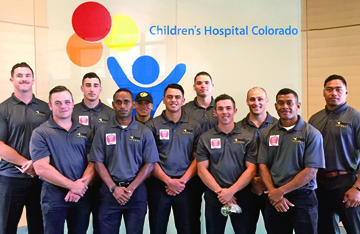 ty to inspire, and be inspired by, these brave children and their families. Outreach is an essential part of being a whole athlete; within the rugby community and especially the Armed Forces, giving back and making an impact is part of who we are. It’s a part of why we serve and why we play this sport.” As the compassion and character embodied by both rugby players and military service members was shown in August, it seems likely the sport has at least a few new young fans.
ty to inspire, and be inspired by, these brave children and their families. Outreach is an essential part of being a whole athlete; within the rugby community and especially the Armed Forces, giving back and making an impact is part of who we are. It’s a part of why we serve and why we play this sport.” As the compassion and character embodied by both rugby players and military service members was shown in August, it seems likely the sport has at least a few new young fans.









